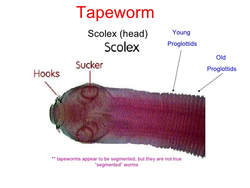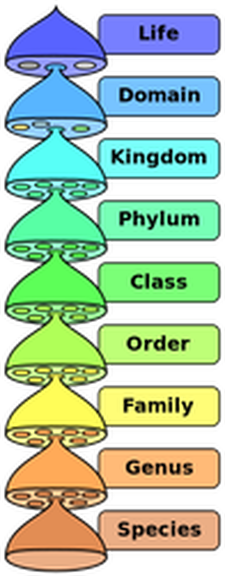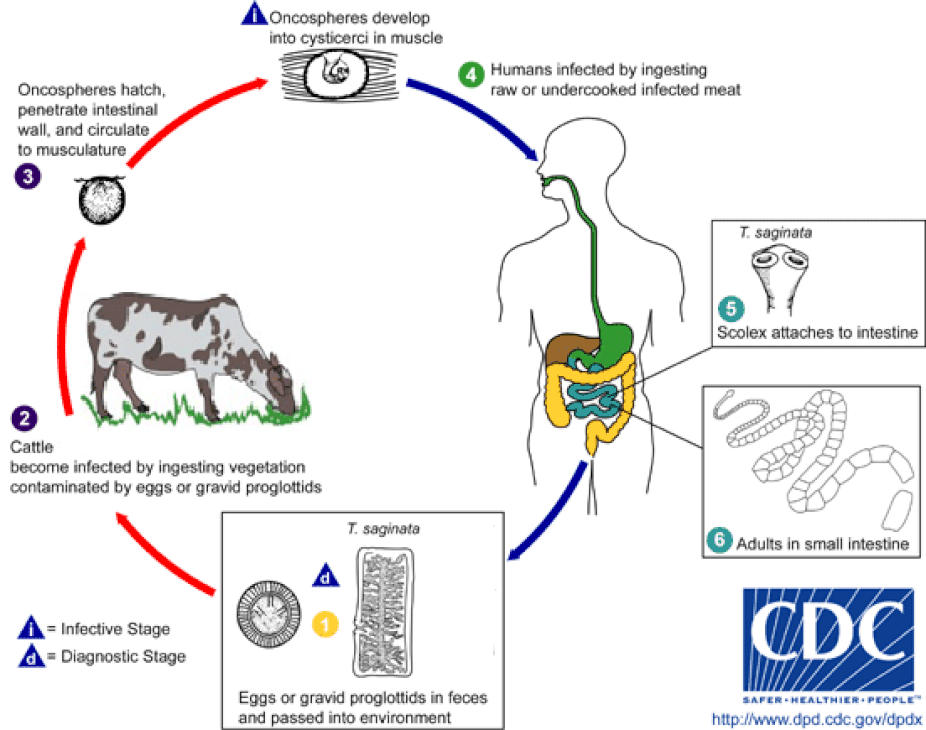Taenia pisiform
There are 3 domains of life. The archaea, the bacteria and the eukarya (or eukaryota) domains. Our friend pictured here, is a Taenia pisiform. This creature belongs to the eukarya domain. The eukarya domain includes the following 4 kingdoms 1) protista, 2) fungi, 3) plantae, and 4) animalia. The Taenia pisiform, is in the animalia kingdom and the invertebrata sub-kingdom.

Animals in the sub-kingdom invertebrata, make up around 95% of the known animal species on Earth. These animals get their name from the fact that they lack an internal skeleton and do not have a backbone. Animals that categorized as "invertebrates" include annelids, arachnids, cnidaria, crustaceans, echinoderms, insects, mollusks, and protozoa.
The Taenia pisiform is an invertebrate belonging to the Platyhelminths Phylum, which is the phylum of flatworms, an they belong to the Cestoda Class, which is the class of tapeworms.
II. Phylum Nematoda - roundworms
Enterobius vermicularis female - pinworm
Label: mouth, pharynx
Trichinella spiralis- threadworm encysted in muscle
Label: cyst, muscle, larva
IV. Phylum Arthropoda
Class Arachnia
Dermatophagoides spp.- dust mite
Label: thorax, legs, abdomen
Kingdom Fungi
A. Division: Zygomycota
Rhizopus stolonifer – Black bread mold. zygote (sexual spore).
label: zygote and hyphae
Rhizopus stolonifer - sporangiospores (asexual spore)
label: sporangium, sporangiophore, and rhizoids
12
B. Division: Ascomycota - sac fungi.
Penicillium notatum - ascospores (sexual spore)
label: cleistothecium, hyphae, ascus, and ascospore
Penicillium notatum - phialospore (a type of conidiospore) (asexual spore)
label: conidia, septa, conidiophore, and hyphae
Saccaromyces cerevisiae – yeast - (asexual spore)
label: parent cell, blastospore
Kingdom Protista
Subkingdom Protozoa - cyst (dormant) and trophozoite (vegetative) stages
I. Phylum Sarcomastigophora - amoebas and flagellates
A. Subphylum Sarcodina - amoebas
Entamoeba histolytica (intestinal parasite)
label: nucleus, food vacuoles Identify whether cyst (4 nuclei) or trophozoite (1 nucleus)
B. Subphylum Mastigophora - flagellates
Giardia lamblia - intestinal parasite
label: nuclei and flagella if seen, Identify whether cyst (4 nuclei) or trophozoite (2 nuclei)
Trichomonas vaginalis - urogenital parasite
label: nucleus and flagella if seen, no cyst stage
Enterobius vermicularis female - pinworm
Label: mouth, pharynx
Trichinella spiralis- threadworm encysted in muscle
Label: cyst, muscle, larva
IV. Phylum Arthropoda
Class Arachnia
Dermatophagoides spp.- dust mite
Label: thorax, legs, abdomen
Kingdom Fungi
A. Division: Zygomycota
Rhizopus stolonifer – Black bread mold. zygote (sexual spore).
label: zygote and hyphae
Rhizopus stolonifer - sporangiospores (asexual spore)
label: sporangium, sporangiophore, and rhizoids
12
B. Division: Ascomycota - sac fungi.
Penicillium notatum - ascospores (sexual spore)
label: cleistothecium, hyphae, ascus, and ascospore
Penicillium notatum - phialospore (a type of conidiospore) (asexual spore)
label: conidia, septa, conidiophore, and hyphae
Saccaromyces cerevisiae – yeast - (asexual spore)
label: parent cell, blastospore
Kingdom Protista
Subkingdom Protozoa - cyst (dormant) and trophozoite (vegetative) stages
I. Phylum Sarcomastigophora - amoebas and flagellates
A. Subphylum Sarcodina - amoebas
Entamoeba histolytica (intestinal parasite)
label: nucleus, food vacuoles Identify whether cyst (4 nuclei) or trophozoite (1 nucleus)
B. Subphylum Mastigophora - flagellates
Giardia lamblia - intestinal parasite
label: nuclei and flagella if seen, Identify whether cyst (4 nuclei) or trophozoite (2 nuclei)
Trichomonas vaginalis - urogenital parasite
label: nucleus and flagella if seen, no cyst stage






